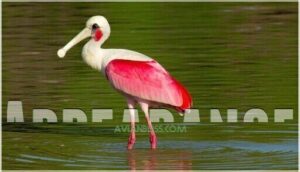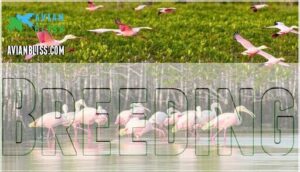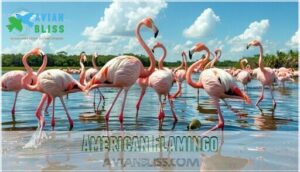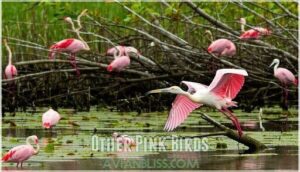This site is supported by our readers. We may earn a commission, at no cost to you, if you purchase through links.
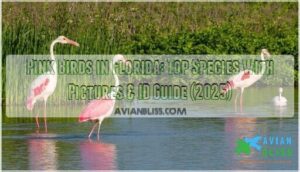 You’ll spot several stunning pink birds in Florida throughout the year.
You’ll spot several stunning pink birds in Florida throughout the year.
The Roseate Spoonbill steals the show with its bright pink feathers and spoon-shaped bill, wading through shallow waters like a feathered flamingo.
Speaking of flamingos, you might catch rare glimpses of American Flamingos in South Florida’s wetlands.
House Finches sport rosy-pink patches on males, while Purple Finches show deeper pink tones.
Roseate Terns flash pale pink undersides during breeding season, and Rose-breasted Grosbeaks pass through during migration with their distinctive pink chest patches.
The exotic Scarlet Ibis occasionally appears as an escaped visitor.
Each species has unique habits, preferred habitats, and identifying features that’ll help you tell them apart.
Table Of Contents
- Key Takeaways
- Pink Bird Species
- Roseate Spoonbill
- Flamingos in Florida
- Other Pink Birds
- Conservation Efforts
- Frequently Asked Questions (FAQs)
- What are the pink birds in Florida called?
- Are pink spoonbills rare?
- What birds in Florida have pink feathers?
- Are there pink ibis in Florida?
- What bird in Florida is pink?
- What is the pink bird that is not a flamingo?
- Which bird is pink in color?
- What are the white birds that turn pink?
- What causes the pink coloration in birds?
- Do pink birds migrate or stay year-round?
- Conclusion
Key Takeaways
- You’ll find the Roseate Spoonbill as Florida’s most iconic pink bird – it’s the only large pink species that actually breeds in the state, with its distinctive spoon-shaped bill making identification easy in wetlands and coastal areas.
- Pink coloration comes from their diet, not genetics – these birds get their vibrant hues from carotenoids in shrimp, crabs, and algae they eat, so well-fed birds show deeper pink colors than others.
- You can spot pink birds year-round, but timing matters for different species – Roseate Spoonbills stay in southern Florida permanently, while Purple Finches only visit during winter months and Rose-breasted Grosbeaks pass through during migration.
- Conservation efforts have helped these species recover from near-extinction – hunting for the feather trade in the early 1900s devastated populations, but habitat protection and the 1918 Migratory Bird Treaty Act allowed them to bounce back.
Pink Bird Species
Florida’s wetlands showcase pink birds that’ll make you stop and stare.
The roseate spoonbill leads this colorful parade, along with occasional flamingo visitors that create picture-perfect moments.
These florida bird species get their rosy plumage variations from munching on shrimp and crustaceans – nature’s own pink food coloring.
Dietary influence directly affects how vibrant they appear, with well-fed birds showing deeper hues.
Pink Bird ID becomes tricky when hybridization risks create unusual color combinations, especially between related species.
Rare sightings of non-native species sometimes pop up, adding excitement to your birding adventures.
Many colorful birds, like the scarlet macaw’s plumage, owe their vibrancy to pigments.
Whether you’re tracking a pink flamingo or identifying other pink birds florida offers, these feathered gems transform ordinary wetland visits into extraordinary wildlife encounters that you’ll remember long after leaving.
Roseate Spoonbill
You’ll easily spot Florida’s most famous pink bird by its unique spoon-shaped bill and brilliant rosy plumage.
The Roseate Spoonbill stands out as the only large pink bird that actually breeds in Florida, making it a true treasure of the state’s wetlands.
Appearance
You’ll spot the roseate spoonbill’s vibrant pink plumage instantly—it’s like spotting cotton candy with wings.
Their distinctive spoon-shaped bill and red legs make identification easy.
The pink coloration comes from carotenoids in their diet, with intensity varying between individuals.
Adults show deeper hues than juveniles, whose markings appear more muted and pale.
You can even find products featuring roseate spoonbill plumage.
Habitat
You’ll discover these stunning wading birds thriving in Florida’s diverse aquatic environments where food is plentiful:
- Coastal wetlands and mangrove ecosystems along the Gulf Coast
- Freshwater habitats including marshes, ponds, and treatment facilities
- Saline lagoons where brackish water creates perfect hunting grounds
Roseate spoonbill habitat spans southern Florida’s wetlands, from the Everglades to Tampa Bay.
These florida birds prefer shallow waters for their unique feeding style, making birdwatching florida adventures rewarding when you know their nesting locations.
Consider habitat product availability if you’re looking to support these birds.
Behavior
Roseate spoonbills showcase fascinating social interactions through their communal roosting and feeding habits.
You’ll spot them sweeping their distinctive bills side-to-side in shallow waters, using specialized feeding habits to capture prey.
These pink birds in Florida display remarkable bird social behavior when forming large flocks during migration.
They thrive in shallow aquatic environments that support their feeding habits.
Their vocalizations include soft grunting sounds during foraging, while their synchronized movements demonstrate complex bird behavior patterns that make them enchanting subjects for wildlife enthusiasts.
Breeding
When these graceful pink birds gather for breeding season, you’ll witness nature’s most organized community effort.
Roseate spoonbills create bustling colonies in mangroves during spring, transforming quiet wetlands into pink-feathered neighborhoods.
Their breeding habits include fascinating mating rituals:
- Males perform elaborate courtship displays with bill-clacking and feather-raising ceremonies
- Pairs work together building stick nests 5-15 feet above water in mangrove trees
- Both parents share parental care duties, taking turns incubating 2-4 speckled eggs for 22-24 days
Chick development happens quickly—young birds fledge within six weeks, though parents continue feeding them several more weeks.
Flamingos in Florida
You’ll spot flamingos in Florida’s southern waters, though they’re more like visitors than permanent residents.
These tall pink birds with their curved beaks occasionally grace the Everglades and Florida Keys, creating quite the spectacle when they do show up.
American Flamingo
When you’re scanning Florida’s coastal waters, the American Flamingo stands out like a pink beacon among the marshes.
These magnificent birds showcase their vibrant plumage through filter feeding on carotenoid-rich algae and brine shrimp.
Their social behavior creates stunning flocks during Florida sightings, especially in the Everglades and Keys.
Their vibrant pink hue is a result of carotenoid pigments in their diet.
| Physical Features | Habitat & Behavior |
|---|---|
| Bright pink plumage coloration | Shallow coastal lagoons |
| Specialized curved bill | Highly social flocks |
| 3-5 feet tall stature | Synchronized group displays |
| Filter feeding adaptation | Mud mound nesting sites |
Greater Flamingo
While American Flamingos grab attention, you’ll also spot Greater Flamingos in Florida’s wetlands.
These elegant Florida birds showcase stunning plumage variation and fascinating feeding habits that make bird identification exciting.
- Habitat Range: Shallow lakes and coastal wetlands across Florida
- Conservation Status: Stable populations with protected breeding areas
- Feeding Habits: Filter algae and crustaceans through specialized bills
- Plumage Variation: Pink intensity varies based on diet richness
These Florida wildlife gems add vibrant color to pink birds in Florida collections.
Other Pink Birds
While the Roseate Spoonbill takes center stage as Florida’s most famous pink bird, you’ll find several other rosy-hued species calling the Sunshine State home.
From tiny finches with salmon-colored caps to rare vagrant ibises with brilliant scarlet plumage, these pink birds add splashes of color to Florida’s diverse avian landscape.
House Finch
You’ll find house finches thriving in Florida’s urban areas, making backyard birding a breeze.
Males showcase stunning pink-red heads and breasts, while females sport streaky brown plumage variation.
Their finch diet includes seeds and fruits from your feeders.
These adaptable songbirds excel at urban adaptation, bringing delightful song characteristics to suburbs.
Perfect for Florida bird identification and bird watching enthusiasts seeking pink birds in Florida.
Purple Finch
Purple Finches bring winter excitement to Florida birdwatching with their stunning raspberry-red plumage variations.
Males showcase vibrant pink heads and breasts, while females display subtle brown streaking.
Their finch diet includes seeds from feeders and native plants.
Though their habitat range primarily spans northern regions, winter sightings occur throughout Florida ecosystems.
Despite stable conservation status, these pink birds remain less common than other finches, making encounters special for Florida birdwatchers seeking diverse pink birds.
- Raspberry-red head glowing like a sunset
- Brown-streaked back resembling tree bark patterns
- White belly contrasting against colorful chest
- Conical seed-cracking bill built for efficiency
Roseate Tern
Beyond Florida’s inland waters, the roseate tern brings elegance to coastal shores with its distinctive pink-tinged breast and deeply forked tail.
These graceful seabirds sport black caps during breeding season and hunt by plunge-diving for small fish. Their Feather Coloration comes from carotenoid-rich prey, making them stand out among other pink birds in Florida.
Tern Migration brings them to coastal wetlands seasonally, where Birdwatching Tips include watching for their aerial dives and listening for their sharp calls.
| Feature | Description |
|---|---|
| Size | 70-80 cm wingspan |
| Breeding | Black cap, pink breast |
| Nesting Habits | Colonial island nesters |
| Conservation |
Near Threatened status.
Seabird Conservation efforts focus on protecting their island breeding sites from predators and human disturbance.
Rose-Breasted Grosbeak
You’ll encounter the rosebreasted grosbeak during migration patterns through Florida’s deciduous forests.
This striking songbird captivates Florida birdlife enthusiasts with its distinctive appearance and behaviors:
- Males display brilliant rose-pink breast patches against black and white plumage
- Food sources include insects, seeds, and berries found in woodland edges
- Song characteristics feature rich, robin-like melodies that enhance birdwatching in Florida experiences
Their nesting behavior involves constructing cup-shaped nests in trees. These breeding habits occur primarily in northern regions, making Florida sightings special treats for coastal wetlands visitors seeking pink birds in Florida.
The rose-breasted grosbeak’s climate change vulnerability is a significant concern for conservation efforts.
Scarlet Ibis
You’ll spot the Scarlet Ibis wading through Florida’s coastal wetlands, flashing brilliant scarlet-pink feathers that make flamingos jealous.
This Caribbean visitor isn’t technically native but breeds in small colonies near Miami and Tampa.
Their vibrant plumage comes from carotenoid pigment found in their crustacean-heavy diet – basically, they’re what they eat!
These pink birds in Florida hunt by probing muddy bottoms with their long, curved bills.
Bird migration patterns bring them here seasonally, where they mix with white ibises.
Their coastal habitat preferences make them easier to find than many other ibis species in the state, due to their preference for coastal wetlands.
Conservation Efforts
You’ll find that Florida’s pink birds face ongoing conservation challenges that require active protection efforts.
These beautiful species have bounced back from near extinction thanks to habitat preservation and hunting restrictions, but they still need your support to thrive.
Habitat Protection
Wetland conservation protects Florida’s pink birds through strategic habitat preservation.
You’ll find these efforts at Everglades National Park and J.N. Ding Darling refuge, where coastal management and pollution reduction safeguard critical nesting areas.
Controlling non-native plant growth is also vital for habitat health.
- Mangrove restoration projects create safe nurseries for spoonbill chicks
- Clean water initiatives guarantee healthy fish populations for feeding
- Climate change adaptation protects against rising sea levels
- Invasive species removal preserves native food webs
Hunting History
During the late 1800s and early 1900s, Early Exploitation through the Feather Trade devastated Florida’s roseate spoonbill populations.
Hunters targeted these wading birds and other coastal birds for fashionable hat decorations, causing severe Population Decline.
The Everglades birds faced near extinction before Regulation Impact through the 1918 Migratory Bird Treaty Act finally banned Modern Hunting of Florida wildlife.
Current Status
Today’s pink birds in Florida show mixed population trends thanks to dedicated conservation efforts.
Roseate Spoonbills are slowly recovering, while flamingo sightings increase due to changing migration patterns.
Current conservation status highlights:
- Roseate Spoonbill populations gradually stabilizing after decades of protection
- American Flamingo sightings becoming more frequent in southern Florida
- Habitat changes from development still threaten nesting areas
- Research updates guide adaptive management strategies for future outlook
Importance
You’ll discover that pink birds in Florida serve as living barometers of ecosystem health while boosting economic impact through birdwatching tourism.
Their aesthetic value creates unforgettable wildlife experiences that support conservation needs.
These remarkable bird species showcase Florida’s bird diversity, making bird habitats worth protecting for future generations.
Frequently Asked Questions (FAQs)
What are the pink birds in Florida called?
Spotting bright pink feathers might make you wonder if flamingos live here naturally.
You’ll find three main pink birds in Florida: Roseate Spoonbills (native), House Finches, and Purple Finches during winter migration seasons.
Are pink spoonbills rare?
Roseate Spoonbills aren’t super rare in Florida, but they’re not exactly common either.
They’re found mainly in southern Florida’s wetlands, especially the Everglades.
Their populations have recovered nicely since conservation efforts began.
What birds in Florida have pink feathers?
While you’d expect flamingos everywhere, Florida’s pink birds are surprisingly few.
You’ll spot Roseate Spoonbills with their spoon-shaped bills, occasional American Flamingos, and rare Scarlet Ibises—plus escaped exotic pets like cockatoos.
Are there pink ibis in Florida?
Yes, you’ll find pink ibis in Florida, but they’re not native.
Scarlet ibis occasionally appear as escapees from collections or hybrids with white ibis, creating pinkish birds near Miami and Tampa areas.
What bird in Florida is pink?
Imagine walking through Everglades National Park and spotting a bright pink bird feeding in shallow water.
You’re likely seeing a Roseate Spoonbill, Florida’s most common pink bird, easily recognized by its distinctive spoon-shaped bill.
What is the pink bird that is not a flamingo?
The pink bird you’re likely spotting isn’t a flamingo—it’s the Roseate Spoonbill.
This stunning wader sports vibrant pink plumage and a distinctive flat, spoon-shaped bill that makes it unmistakable in Florida’s wetlands.
Which bird is pink in color?
Several bird species display pink coloration that you’ll spot in Florida.
The Roseate Spoonbill stands out as Florida’s most prominent native bird, with vibrant rosy plumage and a distinctive spoon-shaped bill for catching aquatic prey.
What are the white birds that turn pink?
Surprisingly, you’ll find that American Flamingos aren’t actually white birds that turn pink.
They’re born grayish-white but develop their stunning pink color from eating shrimp and algae rich in carotenoids throughout their lives.
What causes the pink coloration in birds?
Birds get their pink color from carotenoids, natural pigments found in their food.
When you eat shrimp, crabs, or algae containing these compounds, they’re deposited in your feathers, creating that stunning pink hue you see.
Do pink birds migrate or stay year-round?
You’ll find that migration patterns vary among Florida’s pink birds.
Roseate Spoonbills stay year-round in southern Florida but northern populations migrate seasonally.
Purple Finches only visit during winter months, while House Finches remain permanent residents throughout the state, exhibiting a notable difference in their migration behaviors compared to the seasonally migrating populations.
Conclusion
Sure, you might think pink birds in Florida are just rare visitors, but you’ll be surprised by how many species call the Sunshine State home year-round.
From the iconic Roseate Spoonbill wading through coastal marshes to migrating Rose-breasted Grosbeaks, these pink birds in Florida offer incredible viewing opportunities.
Keep your binoculars ready and visit wetlands during early morning hours for the best sightings.
With proper identification skills and patience, you’ll discover Florida’s remarkable pink-feathered residents thriving in their natural habitats.
- https://www.fnai.org/PDFs/FieldGuides/Ajaia_ajaja.pdf
- https://www.nature.org/en-us/about-us/where-we-work/united-states/florida/stories-in-florida/are-flamingos-native-to-florida/
- https://www.fresnochaffeezoo.org/species/american-flamingos/?gclid=CjwKCAjwxLH3BRApEiwAqX9arcpsmN0Ul6EXV4ose-sSYQUeIZs7dbwOiLMIOGW2vx3a7YUqayNxnxoCqjUQAvD_BwE
- https://www.bird-sounds.net/roseate-spoonbill/
- https://en.wikipedia.org/wiki/Dr._No_(novel)


